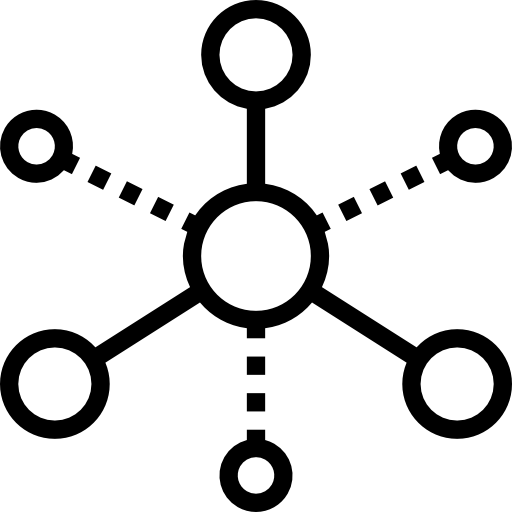Data Center Infrastructure Management Tools: A Free Guide
Planning and operating a state-of-the-art data center is a challenging task due to the need to continuously change the infrastructure while maintaining high levels of both uptime and efficiency. The best solution to manage this challenge is adopting a data center infrastructure management (DCIM) platform.
DCIM, as a platform, consists of a number of multidisciplinary tools that tackle different tasks with the aim of total infrastructure control and optimization. In this article, we discuss some of the most essential data center infrastructure management tools and their most important features.
Summary of data center infrastructure management tool features
The following table depicts the main characteristics or aspects of DCIM tools.
| Feature | Description |
|---|---|
| Capacity planning | Planning for future hardware placement depending on the requirements of optimizing inventory. |
| Change management | Keeping track of activities that impact operations and maintenance as well as individual software, firmware, and hardware components. Planning timely replacements while optimizing inventory. |
| Floor space optimization | Distributing racks across the data center and tracking the positions of every individual rack as well as individual rack features. |
| Rack optimization | Optimization of individual rack loading with IT equipment as well as rack layout tracking and optimization. |
| Continuous infrastructure discovery | Constantly discovering all new components, processes, and features through all infrastructure levels: physical, application, service, and software. |
| Efficiency optimization | Live data gathering about IT load, power, cooling infrastructure, and processing gives insight into the infrastructure’s current state of efficiency and enables optimization to keep efficiency as high as possible. |
| Sustainability tracking and optimization | This includes tracking parameters such as total infrastructure CO2 offset, power, and water utilization factors. |
| Visualization | Data visualization enables insight into historical and live trends as well as the status of infrastructure operations. |
| Documentation | Creating documentation that is consistent with internal standards and best practices keeps personnel aligned with organizational goals. |
| Reporting | Reporting is necessary to ensure that management’s expectations are met and that activities adhere to internal standards. |
Key attributes of data center infrastructure management tools
Capacity planning
It’s necessary to plan for future load expansions and to make sure that the existing infrastructure is adequate for these expansions.
Capacity planning is a paradigm consisting of different tools, including data center room layout tools, rack diagram generators, and IT patch panel management. These tools enable organizations to optimize their infrastructure resources and ensure smooth operations by leveraging real-time monitoring and analytics.
DCIM systems can provide accurate insights into power consumption, cooling requirements, and space utilization, considerations that it’s important to be constantly mindful of. This information allows data center operators to forecast and plan for future growth and anticipate capacity needs based on actual data rather than relying on estimations or guesswork.
Some of the considerations to take into account as part of capacity planning include:
- Available space
- Potential power
- Budgeted power
- Copper, fiber, and power ports
- Weight
- Number of items in the cabinet
- Available rack units
- Largest number of contiguous rack units
DCIM is critically important in capacity planning. For example, organizations experiencing rapid expansion can utilize DCIM to identify available rack space, power capacity, and cooling capacity in real time. This enables them to efficiently allocate resources and avoid potential bottlenecks or over-provisioning in terms of rack space, electrical power, or cooling capacity.
DCIM goes beyond this, however, allowing for scenario modeling and “what-if” analysis that allows operators to simulate different scenarios and evaluate their impacts on capacity requirements. By leveraging DCIM’s comprehensive insights, organizations can make informed decisions, optimize resource utilization, and ensure that their data center infrastructure aligns with current and future capacity demands.
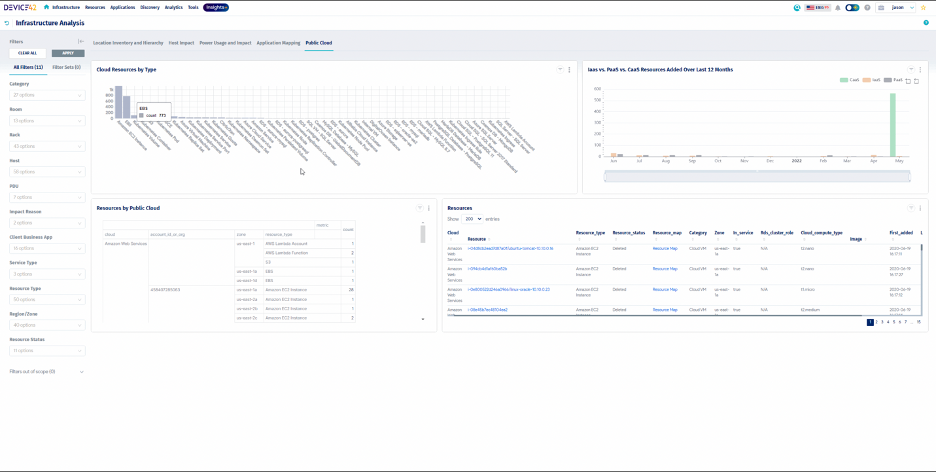
Public cloud dashboard (Source: Device42)
Change management
DCIM involves implementing specific practices to track changes made within a data center environment. This includes the key practice of monitoring implemented components and watching their end-of-life periods. A centralized change management module within the DCIM system can make this much easier than manual work.
The use of tools such as spare part management enables the optimization of inventory and minimizes the time needed for personnel to react in case of maintenance activities on the infrastructure. This feature allows operators to create and track change requests, including equipment installations, modifications, and decommissioning. It provides a structured and standardized approach to change management, ensuring proper documentation, approvals, and tracking of changes. It also keeps track of the inventory and ensures timely new equipment ordering.
Integration of DCIM tools with other IT service management tools enables seamless coordination and communication between different teams involved in change management processes. This integration allows for efficient collaboration, visibility, and accountability throughout the change lifecycle.
Real-time monitoring and alerts within the DCIM tool help identify and mitigate potential risks associated with changes, such as power or cooling adequacies. In this way, human errors are reduced, operational stability is enhanced, and compliance with regulatory requirements within the data center environment is assured.
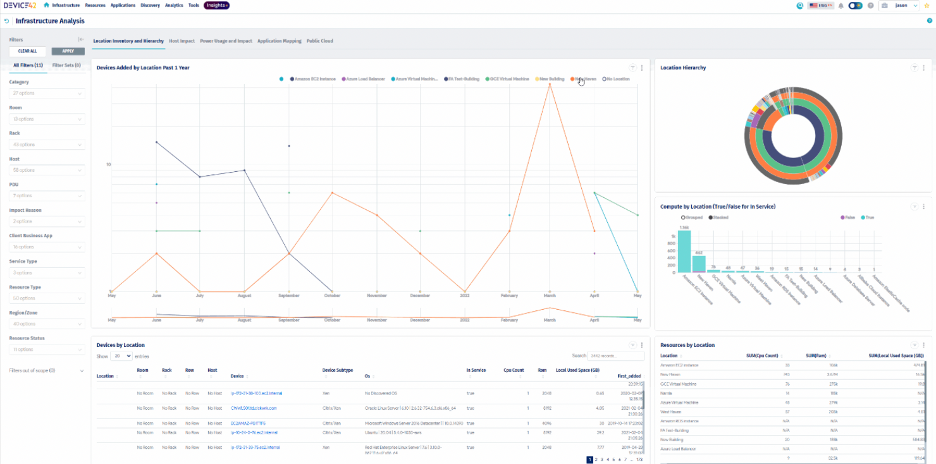
Location inventory and hierarchy dashboard (Source: Device42)
Floor space optimization
DCIM tools can help with continuously monitoring the positioning of every rack in the data center and planning for future rack placement. It’s important to be mindful of the power and cooling constraints while planning rack positioning.
One of the key practices in data center operation is utilizing the accurate space monitoring and visualization provided by DCIM systems, which are incorporated into the data center room layouts tool. By utilizing floor layout plans and three-dimensional models, operators can identify unused or underutilized areas and make decisions for efficient space allocation.
Another best practice is implementing intelligent capacity planning. DCIM allows operators to assess space requirements, plan for future growth, and ensure the optimal placement of racks and equipment to minimize wasted space. Also, utilizing precise cable management within DCIM helps optimize floor space by organizing cable routing and reducing clutter.
Virtualization and consolidation are also essential practices for floor space optimization: DCIM systems provide insights into server utilization and facilitate workload consolidation, allowing operators to reduce the number of physical servers and free up valuable floor space.
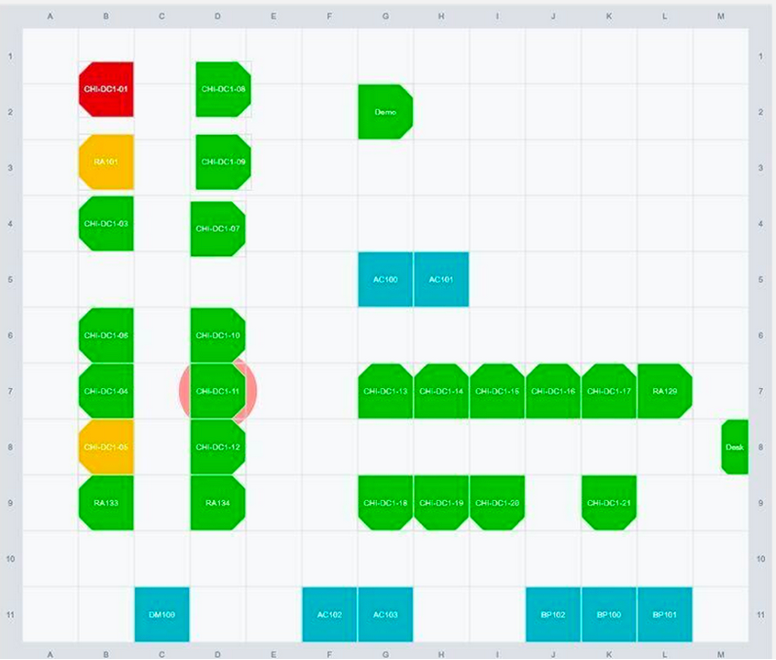
Data center room layout (Source: Device42)
Rack optimization
Data center managers need to keep track of individual IT devices placed in every rack. They must be mindful of each rack’s physical, electrical, and thermal loading. Planning by using capacity planning tools, such as rack diagram generators and visualization features, can enhance this process. Some of the resulting benefits include maximizing space utilization, improving airflow management, and optimizing power distribution within racks.
One key practice in this area is utilizing intelligent rack placement based on power and cooling requirements. DCIM systems analyze power and thermal data, allowing operators to strategically position high-density and high-heat-generating equipment to avoid hotspots and optimize cooling efficiency.
Another good idea is implementing accurate and granular power monitoring at the rack level, or even at the device level, within the rack, enabling operators to identify power usage patterns, allocate power resources efficiently, and avoid overloading. The information gathered can be used for overall data center operation optimization, as discussed later in the article.
Cable management also plays a crucial role in rack optimization, with DCIM providing visual representations of cable connections. Doing this ensures organized and efficient cable routing for optimal airflow and better maintenance.
Finally, utilizing asset tracking within DCIM allows operators to monitor equipment installation and decommissioning, keeping racks effectively utilized. By applying these best practices, DCIM enables data center operators to optimize rack capacity, minimize energy consumption, and enhance overall operational efficiency.
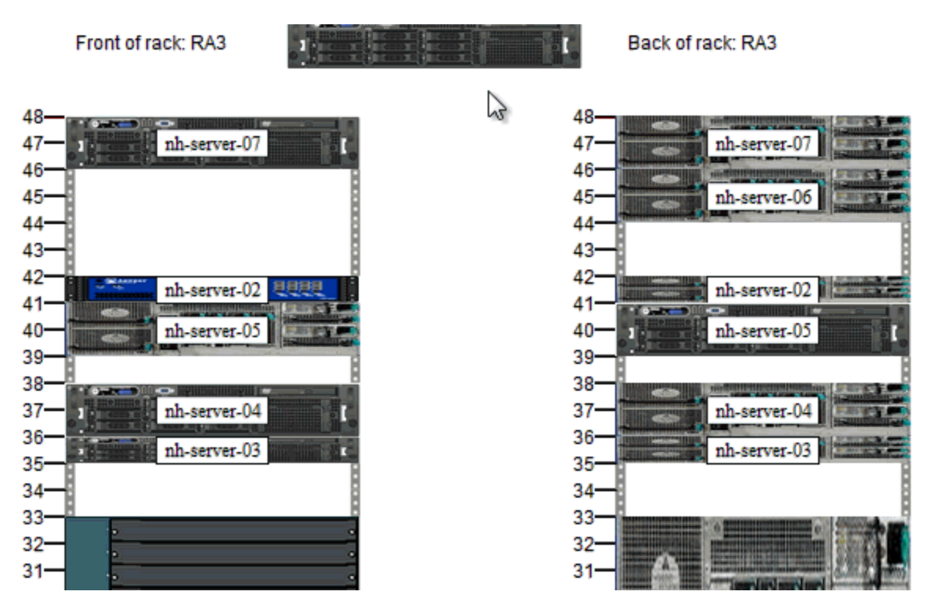
Auto-Generation of rack diagrams (Source: Device42)
Continuous infrastructure discovery
Another important practice is being sure to track all live processes at all levels of the infrastructure. Update software regularly, keep track of existing and new applications and services, and update information at the component level for all hardware categories: IT, electrical, mechanical, and automation. One very good practice is the use of an automated data center management tool enabling autodiscovery at all infrastructure levels.
By utilizing network scanning and SNMP polling, DCIM can identify and automatically discover new devices and equipment as they are added to the data center environment. This includes not only IT equipment such as servers and switches but also the electrical power and cooling parts of the infrastructure.
Additionally, DCIM can integrate with asset management databases and configuration management tools to cross-reference and validate discovered assets. Regularly scheduled discovery scans and automated reconciliation processes ensure the accuracy and consistency of the infrastructure inventory, minimizing manual data entry errors and inconsistencies. Continuous infrastructure discovery using DCIM promotes data accuracy, simplifies asset tracking, and enhances overall operational effectiveness within the data center environment.
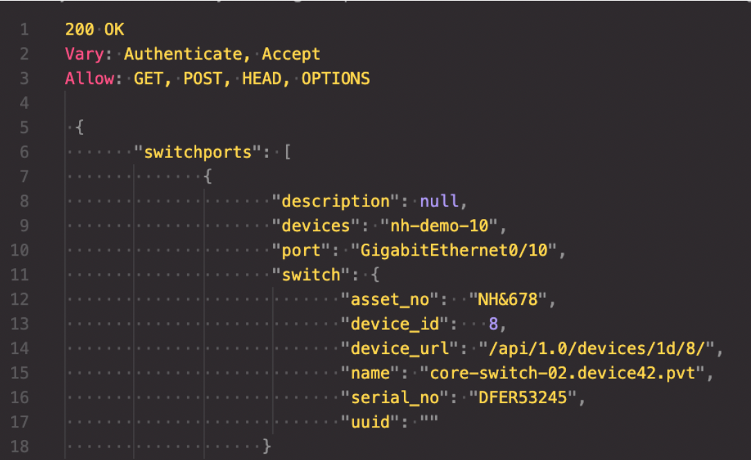
Automated data center management (Source: Device42)
Efficiency optimization
Keeping track of the current state of the infrastructure’s loading, power, and cooling requirements is essential: Based on the data acquired, automation can be applied to optimize the operational efficiency of the infrastructure. Efficiency optimization is actually a paradigm achieved in data centers through the use of energy-efficient hardware and DCIM tools related to power and thermal management.
Here are a few best practices to consider in this area:
- Power capping: Setting limits on power consumption for individual servers or racks, preventing energy waste and ensuring optimal power usage.
- Utilizing intelligent cooling control: DCIM monitors temperature and airflow, adjusting the cooling system to minimize electrical energy consumption while maintaining optimal temperature conditions for active loads.
- Virtualization management: This feature allows data center operators to consolidate workloads and increase server utilization. DCIM provides insights into server performance, allowing operators to identify and decommission idle or low-utilization servers and to consolidate processes on more efficient servers, further enhancing efficiency.
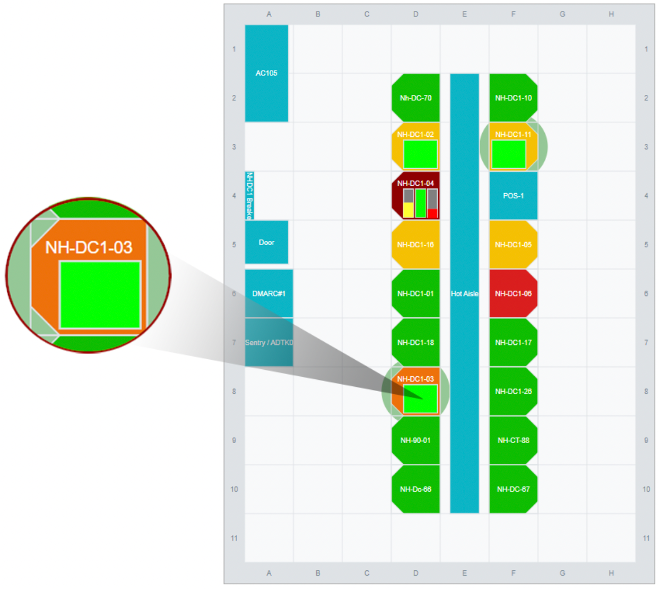
Power management (Source: Device42)
Sustainability tracking and optimization
Data center managers need to track the parameters that directly impact sustainability, such as power and water usage, as well as the carbon footprint allocated to data center operation. DCIM enables precise monitoring and measurement of consumption, allowing operators to assess energy usage and identify areas for improvement.
By analyzing energy efficiency metrics, such as power usage effectiveness (PUE), water usage effectiveness (WUE), and data center infrastructure efficiency (DCIE), DCIM provides insights into the overall energy efficiency of the data center. Through real-time monitoring and reporting, DCIM enables operators to track and analyze CO2 emissions resulting from power consumption, setting targets for reducing the carbon footprint and implementing strategies to achieve sustainability goals. Combining precise monitoring, analytics, and targeted improvements allows DCIM to play a crucial role in ensuring that data centers operate with optimal energy efficiency and minimal environmental impact.
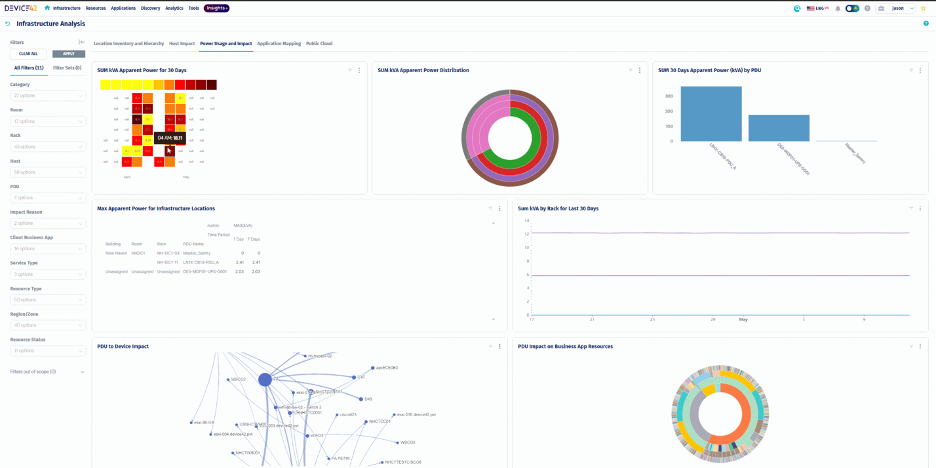
Power usage and impact dashboard (Source: Device42)
Visualization
Visualization is one of the most important features in DCIM and is applied to data center components and systems as well as to the information retrieved from the live operation. Visualizing data center infrastructure components and systems is of great assistance to administrators, minimizing risk and connecting individual component information directly to databases through graphical interfaces. Some of the areas influenced can be seen in this article, such as the discussions of capacity planning, floor space optimization, rack layout, etc.
A second part of visualization is used to draw conclusions and make decisions as quickly as possible. The same visual data can also be used later for documentation and reporting.
With data center infrastructure management tools, data visualization enables data center operators and administrators to gain valuable insights into the performance, capacity, and efficiency of their infrastructure. The data can be presented in different formats, such as charts, graphs, and dashboards, and key metrics such as power consumption, temperature, and server utilization can be easily understood and monitored in real time. Data visualization in DCIM helps identify trends, anomalies, and potential issues, enabling proactive decision-making, resource allocation, and optimization. It gives insight to the stakeholders on different subjects such as operational efficiency and ensures the smooth functioning of data center environments.
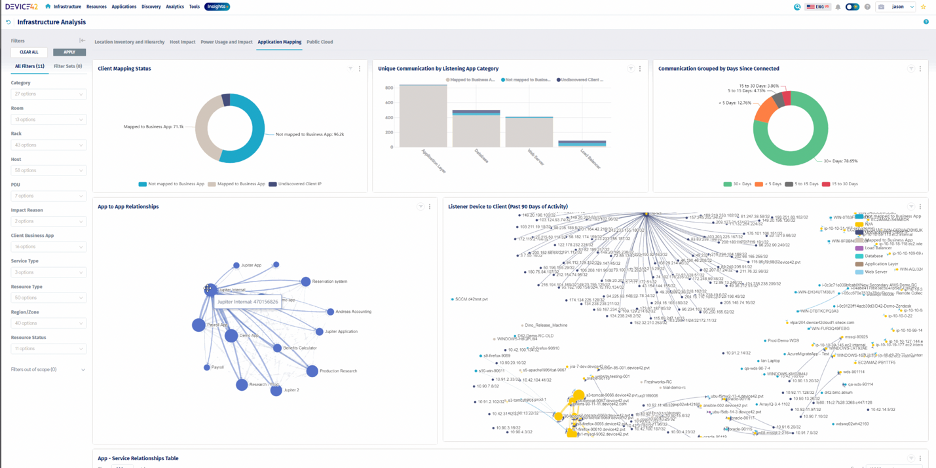
Application mapping dashboard (Source: Device42)
Documentation
Documentation is an essential part of running an efficient and effective data center. As part of the process, you’ll want to make sure to use a DCIM set of tools that is the closest match to the requirements of the operation and emphasize best practices to your team to get the most out of the results.
Documentation traceability refers to the ability to track and link documentation, such as design plans, equipment specifications, and operational procedures, to specific components and activities within the data center. These documents are securely stored in a centralized repository, accessible to authorized personnel, enabling easy retrieval and reference. They provide valuable insights into the data center’s configuration, connectivity, and history, aiding troubleshooting, capacity planning, and compliance audits. DCIM provides efficient search capabilities, version control, and access controls, ensuring the appropriate use of documentation while maintaining data integrity and confidentiality.
One of the important features of DCIM is a configuration management database (CMDB), a centralized repository that stores IT environment data and relationships between IT assets or configuration items. It includes software, hardware, network, and storage components, allowing the monitoring, tracking, and management of the entire IT infrastructure from a single location. CMDBs facilitate crucial business decisions by revealing asset relationships, enabling quick service migration, preparing for end-of-life cycles, and enhancing security and compliance by understanding interactions with sensitive data.
Reporting
Last but not least, it’s important to regularly report findings to the operations team and management in a suitable form that will enable them to bring better quality decisions promptly. These reports provide valuable insights into the performance, capacity, and health of the data center.
Through DCIM reporting tools, operators can analyze power usage, cooling efficiency, asset utilization, and environmental conditions, among other key metrics. These reports aid in identifying inefficiencies, optimizing resource allocation, and making informed decisions for capacity planning and infrastructure upgrades. By visualizing data clearly and concisely, DCIM reporting enables different stakeholders to understand the current state of the data center, which enables operations and management to track progress and take the necessary actions to enhance operational efficiency and maintain service uptime.
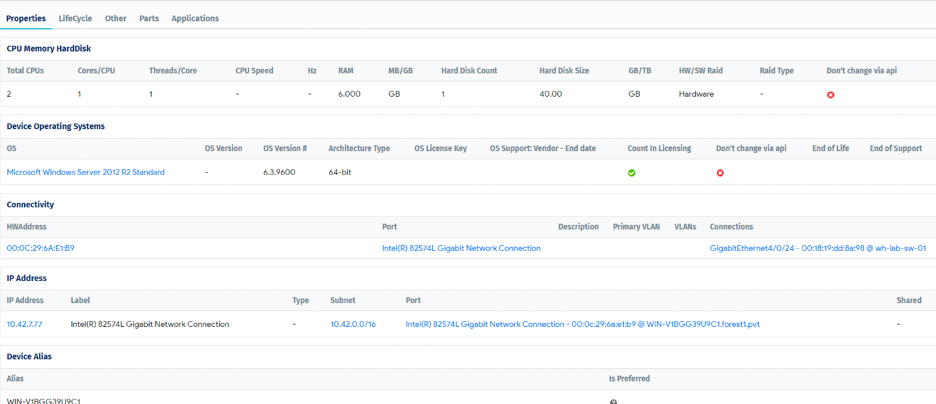
Detailed device information (Source: Device42)
Summary of key concepts
DCIM is a comprehensive solution that addresses various critical aspects of data center operations and management. The main topics covered in this text—including capacity planning, change management, floor space optimization, rack optimization, continuous infrastructure discovery, efficiency optimization, sustainability tracking, visualization, documentation, and reporting—highlight the significance of DCIM in ensuring efficient and sustainable data center operations.
By utilizing data center infrastructure management tools, data center operators and managers can make informed decisions about resource allocation, enabling them to effectively plan for future growth and avoid potential capacity-related issues. DCIM tools cover a range of subjects, each fundamental to the operation of a data center. It is important to have DCIM tools that meet the requirements of both data center operation personnel and management and to integrate them to seamlessly work together, ensuring the health, resilience, and uptime of critical infrastructure.



